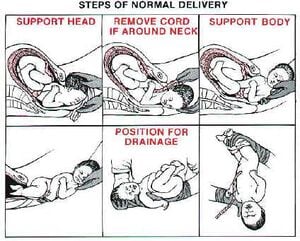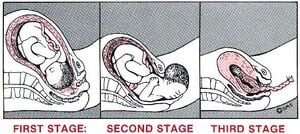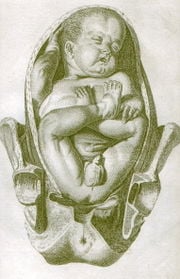
When most people think about giving birth they plan on it being in a hospital where the doctors does everything and they do nothing more than push when they're told to -- but complications do occur and sometimes getting to the hospital or getting medical attention to you is impossible, in which case it is always helpful to know what would need to be done in a situation as such.
Three Stages[edit | edit source]

Stage 1[edit | edit source]
- The main purpose of the first stage is for the womb contracts by itself to open and bring the baby down the birth canal [1]. This found much easier if the mother is kept calm and relaxed as well as occupied.
The following events occur as part of the first stage of labor and delivery.
- The state of dilation: the first signs may be noticeable only to the mother, low-backache and irregular
- cramping pains (contractions) in the lower abdomen.
- As labor progresses, the contractions become stronger, last longer, and become more regular. When the contractions recur at regular 3-4 minute intervals and last from 50-60 seconds, the mother is in the latter part of the first stage.
- The contractions will get stronger and more frequent. The mother will often make an involuntary, deep grunting, moan with each contraction. The delivery of the baby is now imminent [2]
- An important thing to know for friends or family members with the mother is to time her contractions so they know how far along she is. You will do this by placing your hand on her abdomen and timing from the moment it starts to get hard to the moment it becomes fully relaxed. It is also very important to be extremely attentive to the mother. For instance if she is thirsty, get her a drink (particularly ice chips), if she is hungry, bring her a small amount of food. The main concern for a safe a healthy delivery is to make sure the mother is completely relaxed.
- This, unfortunately for you the husband, is probably the stage you dread most while watching those pregnancies on TV and noticing how verbally abused the husband usually gets. Well don't worry it's completely normal because this is the most uncomfortable stage for a delivering mother, how could you blame her. It is during this stage that symptoms such as vomiting, crying, backache, and even possibly trying to back out of the pregnancy will occur. The best thing you could do as a friend or husband at this time would be to act as cheerful and happy as possible (even though you're probably scared to death), knowing you're scared too will no make matters any better for the mother about to pop a child out of her.
- As stated earlier, relaxation is the most important part of the delivery. Make sure that she is taking deep breathes (making her stomach rise a fall) but not to fast, for it might result in a temporary tingle sensation in her hands and feet.
- When the womb is almost fully opened the baby will soon enter the birth canal, and there will be a vocalized catch in the mother's breathing when she has a contraction. The will signal the onset of the second stage [3].
Stage 2[edit | edit source]

- It is during this stage where the mother will become inclined to push along with the transactions in hope of getting the baby out as soon as possible.
- Unlike the contractions of the first stage, which were close together, the contractions of the second stage are a lot farther apart.
- It is extremely important in this stage that both the mother and everyone around her stays CALM! Another important factor is to make sure all the utensils used are sterile. The position the mother should take at this time would be to lie on her back with her knee's bent and straddled as far apart as possible.
- Once the baby's head is visible it is important for the mother no longer push but pant so that the baby starts to slide out. After the baby's head pops out you must support it with your hand and wipe it's face with a sterile cloth.
- It is also during this stage that the baby is completely delivered from the mother
Stage 3[edit | edit source]
- The final stage in the delivery process is the delivery of the placenta or "afterbirth".
- This happens a few minutes to a few hours after the baby is born. When the placenta appears, grasp gently and rotate it clockwise. Then tie the cord in two places--about six inches from the baby--using strips of material that has been boiled or held in a hot flame. [4]
Common Mistakes and/or Complications[edit | edit source]
Umbilical Cord around the neck[edit | edit source]
- A complication that is very common in a lot of deliveries is where the umbilical cord gets wrapped around the babies neck. If you face a situation such as this work your forefinger between the cord and the baby's neck, gently but quickly slip the cord over the baby's head. What ever you do, don't cut the chord. If it is harder to slip over the head then you thought don't worry about it and proceed with the delivery.
Breech Birth[edit | edit source]
- Breech birth is when the baby start to come out of the vaginal cavity buttocks first opposed to head first.
(4) Categories
- Frank Breech. The baby's bottom comes out first
- Complete Breech. The baby is sitting cross legged
- Footling Breech. One or both feet come out first
- Kneeling Breech. The baby is in a kneeling position, with one or both legs extended at the hips and flexed at the knees. This is a rare situation.

Premature Birth[edit | edit source]
- A baby is considered premature if he/she was born before seven months, or weighs less than five and one half pounds, after birth.
- Premature babies are more susceptible to respiratory diseases and infection and must be given special care.[5]
Others[edit | edit source]
- Wedged Shoulders
- Excessive Bleeding
- Multiple Births
- Convulsions